Rivet and Detail
|
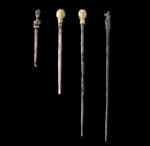
Photo Copyright 2005
David Xavier Kenney |
| Greek Hair Pin 1, Greek Hair Pin 2, Greek Hair Pin 3, and a Roman Hair Pin
Private Collections of: Renee Z. Bakarian, David Xavier Kenney, and Linda Rouleau.
Copyright 2005 David Xavier Kenney. All Rights Reserved.
Click here to view larger image. |
|
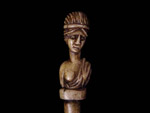
Photo Copyright 2005
David Xavier Kenney |
|
Detail of Greek Hair Pin 1: A Magentic Victrix of a Footrace
From an Antquities Dealer in Germany it appears to have been ritually broken in ancient times (there is engraved art on where the break is). Although it is Greek it may be from the Roman Period. It is made of Ivory. The pin's top shows a woman in the headband of a Victrix of a footrace with her right breast exposed, she may also be an Amazon.
Private Collection of David Xavier Kenney.
Copyright 2005 David Xavier Kenney. All Rights Reserved.
Click here to view larger image. |
|
|
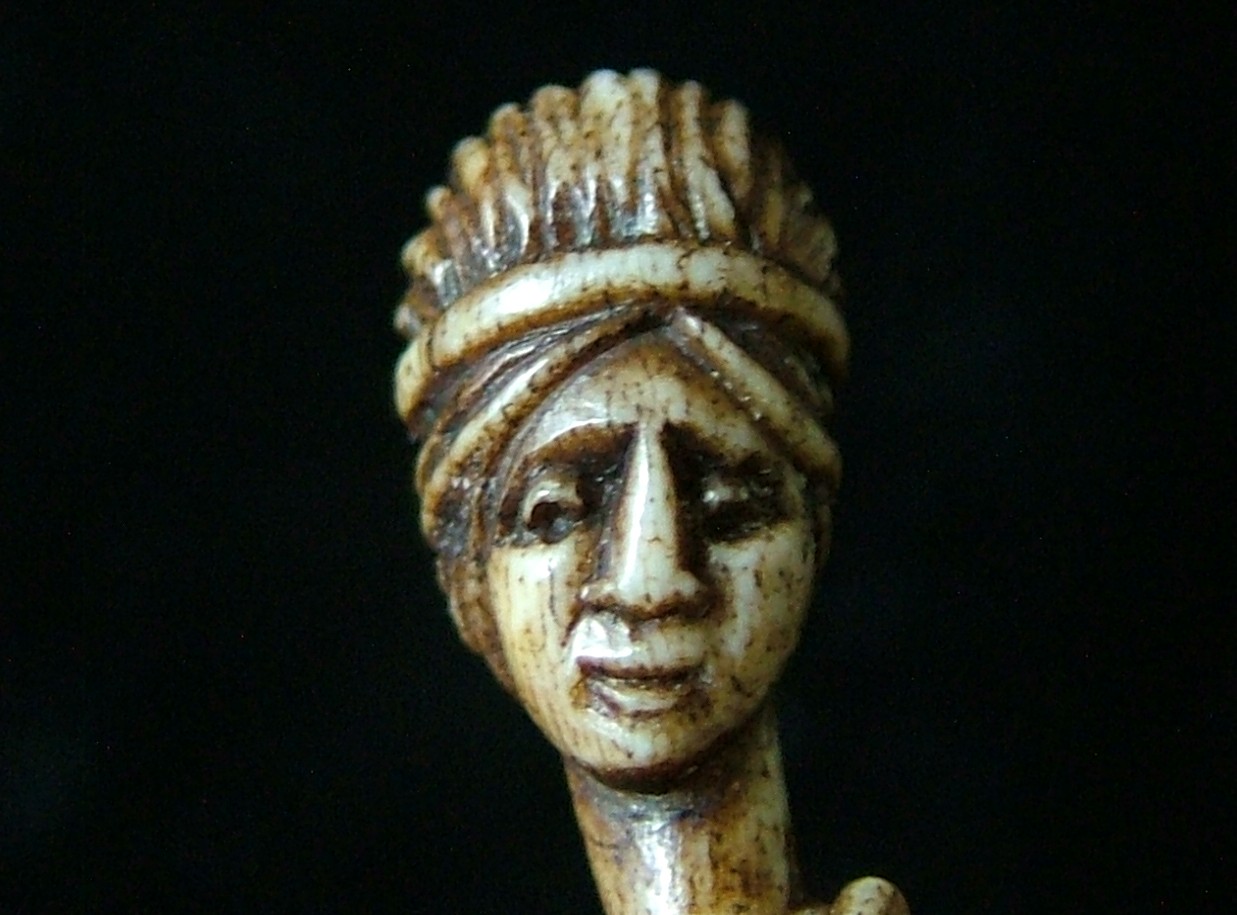
Photo Copyright 2009
David Xavier Kenney |
|
Detail of Greek Hair Pin 1: More Info.
The detail shows that the finishing technique on this pin was with brown dye (or soot mixed with resin) and a lead mercury wash (on certain engraved areas). The technique with the latter allows for light reflection that will transform a figure or scene when the pin is slightly moved. Much of the symbolism of this is not understood, but after studying the detail it shows that it is of a goddess or heroine that is a Victirx in a footrace and that she is also of the magnetic north, she may be an Amazon (or a former Amazon) connected to the goddess Artemis and, or the heroine Atlanta. Her facial features appear to be of a North African, but yet most of the symbolism on the pin is European or Eurasiano Of special interest with her face is her nose, it distinctly represents a Roman Era female stimulator (examples can be seen further down on this page). The first two of those stimulators are in the same form, bit are connected to fertility and magnetic north, hense they give an answer as to a main theme of this pin. My research with symbolism on countless artifacts shows that the ancients associated the magnetic with a mystical sexual act or union in the far north. When of a union then the sex of the participants can vary, it includes different combinations of sexual preference with gods, goddesses, exceptional humans, or creatures - With that said it should be noted that usually certain feminine predatory aspects seem to predominate. It appears that unlike moderns that the ancients associated the far northern regions with their idea of mystical creation, sexual prowess, and sexual liberation.
Click here to view larger image. |
|
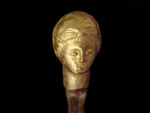
Photo Copyright 2005
David Xavier Kenney |
|
Detail of Greek Hair Pin 2
From an Antiquities Dealer in Germany this pin appears to have been ritually broken in ancient times. Although Greek it may be of the Roman Era. It is made of Gold and Bone. Preliminary research suggests that this miniature bust top may be of Berenice Syria (Berenice Phernophorus). There is punch dot work on the gold foil top that suggest rays or hair. This may represent the Berenice's hair in which a constellation was to be named, but according to the poem by Callimachus, Berenice's hair is storied from events of Berenice II, not Berenice Syria. Berenice Syria won chariot victories at the Isthmian Games, the Nemean Games, and the Olympic Games (132nd Olympics?). Her victories are also thought to have been as the owner of the chariot teams.
Private Collection of Renee Z. Bakarian.
Copyright 2005 David Xavier Kenney. All Rights Reserved.
Click here to view larger image. |
|
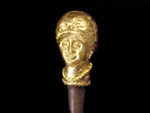
Photo Copyright 2005
David Xavier Kenney |
|
Detail of Greek Hair Pin 3
From an Antiquities Dealer in Germany, although it is Greek it may be of the Roman Era. It is made of Gold and Silver. Preliminary research suggests that this miniature bust top is of Berenice II. Berenice II won chariot victories at the Nemean Games and Olympic Games. Her victories are also thought to have been as the owner of the chariot teams. Berenice II was a Warrior Queen who was also an accomplished equestrian, she appeared on a horse on at least one battlefield.
Private Collection of Linda Rouleau.
Copyright 2005 David Xavier Kenney. All Rights Reserved.
Click here to view larger image. |
|
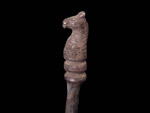
Photo Copyright 2005
David Xavier Kenney |
|
Detail Of Roman Hair Pin
From an Antiquities Dealer in Germany. It is made of Silver. The miniature horse's head top could be associated with either a Roman god, a Roman goddess, or the Roman Cavalry. Engraved and centered along the horse's mane are the following letters, or letters and numbers, X I V N V I. Most Roman hair pin top examples show a feminine nature, although it is not unusual to see other Roman hair pins that are topped with a figure that has a martial quality. At least one Roman writer mentions a Roman aristocratic women using a hair pin as weapon.
Private Collection of Linda Rouleau.
Copyright 2005 David Xavier Kenney. All Rights Reserved.
Click here to view larger image. |
|
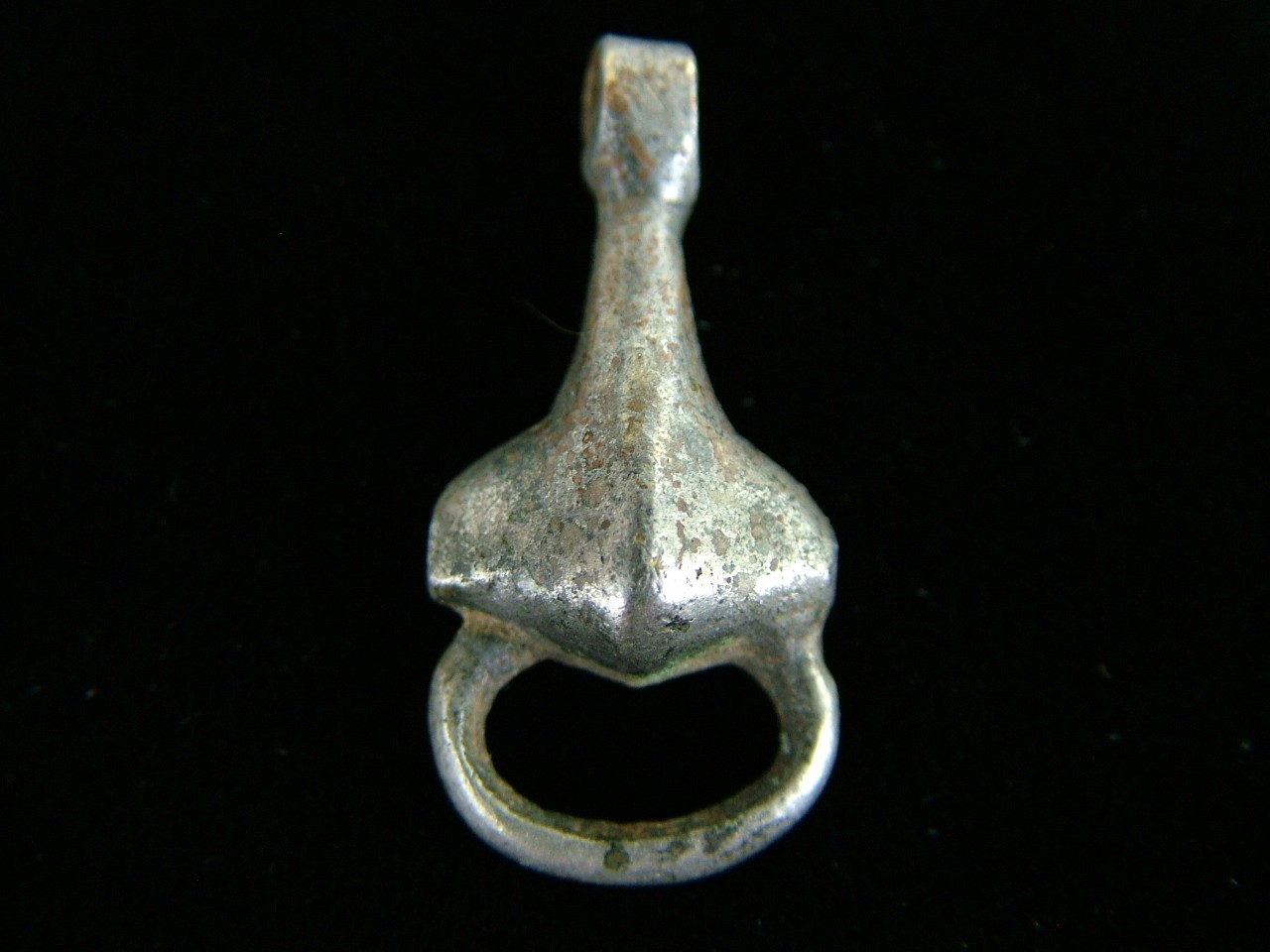
| Photo
Copyright 2008 |
| David
Xavier Kenney |
|
ROMAN GERMANIC SAXON WOMAN'S OATH HEAD BAND PENDANT
|
Our archive is still under construction. Once completed it will include detailed information and pictures of this artifact. The pendant is made from a silver/lead/mercury alloy overlay on bronze with gold wash and copper gilding, there is one gold Insert and tinted sand with resin. It is of the 3rd to 4th Century AD and originates from an Antiquities Dealer in Germany. Among other things it has a primary theme of; a hammer, the magnetic, thunder/lightning, and duel meteors/meteorites. This is of a Saxon thunder/war god associated with; fertility, an armor smith, and a goddess of armor smiths. At least some of the pendant's symbolism may represent what would later become known to the Norse as a Valkyrie, although according to the miniature art unlike the plain Norse version, this goddess is a dark semi-erotic figure that could take heads. There are indicators that this pendant had been made by a legionary armorer of Saxon or Goth heritage.
|
|
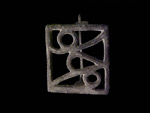
Photo Copyright 2005
David Xavier Kenney |
|
Roman Greek Bronze Brooch
From an Antiquities Dealer in Germany. This brooch is designed to represent a charioteer and chariot.
Private Collection of Linda Rouleau.
Copyright 2005 David Xavier Kenney. All Rights Reserved.
Click here to view larger image. |
|
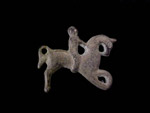
Photo Copyright 2005
David Xavier Kenney |
|
Roman Greek Bronze Brooch
From an Antiquities Dealer in Germany. This brooch is designed to represent a horse and rider, although the design of the front is also made as to represent the front of a chariot with a hitch arm. The horse may or may not represent a unicorn. This brooch definitely shows Celtic and Steppe influence.
Private Collection of Renee Z. Bakarian.
Copyright 2005 David Xavier Kenney. All Rights Reserved.
Click here to view larger image. |
|
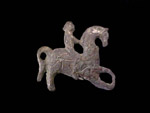
Photo Copyright 2005
David Xavier Kenney |
|
Roman Greek Silvered Bronze Brooch
From an Antiquities Dealer in Germany. This brooch shows Scythian rider on a a hippogriffin, although the design of the front is also made as to represent the front of a chariot with a hitch arm. The mythological hippogriffin is not thought to have been used in art until the Middle Ages. The Scythian rider may represent the Sythian/Sarmatian sun god Khursun, although the hippogriffin could also suggest a connection to the Sarmatians. The reason for this speculation is that it was thought that the mating of a griffin (Scythians) with a horse (Amazons) produced a hippogriffin. The Greek historian Herodotus claimed that the Sarmatians were descended from Scythian fathers and Amazon mothers. According to the Roman poet Virgil the very idea of a hippogriffin symbolized an attempt at the impossible, such was a similar Roman view of the legendary Amazons.
Private Collection of David Xavier Kenney.
Copyright 2005 David Xavier Kenney. All Rights Reserved.
Click here to view larger image. |
|
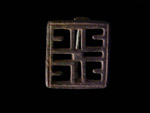
Photo Copyright 2005
David Xavier Kenney |
|
Roman Bronze Brooch
From an Antiquities Dealer in Germany. The design of this brooch has a Greek cross (Equal armed cross) but it also shows a grate. This grate symbolism should be of that which was used during the taurobolium (Bull sacrifice) of the cultic rites of the goddess Cybele. The grate is also one of the symbols of St. Lawrence, this saint is one the Three Saints of Rome.
Private Collection of Linda Rouleau.
Copyright 2005 David Xavier Kenney. All Rights Reserved.
Click here to view larger image. |
|
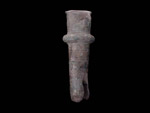
Photo Copyright 2005
David Xavier Kenney |
|
Greek Or Roman Bronze Torch Holder
From an Antiquities Dealer in Germany. This is an extremely rare Greek or Roman bronze torch holder which has had two top finger grips hammered onto one side. Due to this unique feature this could very well be a runner's torch holder. If so then this would be the only example of an ancient runner's torch holder known. For the ancient Greeks a torch run or a torch relay usually would have been to honor one of the gods associated with fire, such as Prometheus or Hephaestus. Other Greek torch runs or torch relays were for goddesses such as; a mounted night torch relay honoring the Thracian goddess Bendis, a torch run (or relay?) to honor Athena, or a girl's torch race which was part of a festival of the all female cult of Artemis at Brauron. The ancient Olympics never had a torch relay as do our modern Olympics, that is since the first Olympic torch relay of 1936. If this torch holder is of a Roman origin then it would most likely would have been used by legionaries, or others that were of the field. The torch holder measures 13 1/2 cm x 5 cm at it's widest width.
Private Collection of David Xavier Kenney.
Copyright 2005 David Xavier Kenney. All Rights Reserved.
Click here to view larger image. |
|
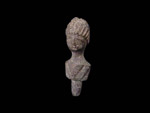
Photo Copyright 2005
David Xavier Kenney |
|
Roman Celtic Bronze Hair Pin Top
From an Antiquities Dealer in England. This is a Roman hair pin top of the Celtic Gaulish Brigandu, a goddess of arts, crafts, and fertility. Her pagan Irish equivalent was Brigid, a Celtic warrior goddess who represented fire but who was also associated with healing waters and fertility. Brigandu was a threefold goddess but unique in that all three were youthful. St. Bridget of Ireland is thought to be of this goddess.
Private Collection of Linda Rouleau.
Copyright 2005 David Xavier Kenney. All Rights Reserved.
Click here to view larger image. |
|
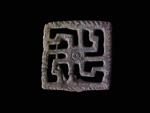
Photo Copyright 2005
David Xavier Kenney |
|
Roman Celtic Bronze Brooch
From an Antiquities Dealer in the Netherlands. This is a Roman Celtic Square brooch with four stylized, crossed flaming torches forming a swastika. The brooch is bordered by a rope motif and has a circle/dot on the center square. This cross appears to symbolize the Celtic Gaulish goddess Brigandu, who was associated with arts, crafts, and fertility. In Celtic Ireland she was known as Brigit, in Celtic Scotland as Bride, and in Celtic Britain as Brigantia. This brooch shows that the Celtic Gaulish Brigandu may have had much more in common with the Celtic Irish goddess Brigit than was previously known. The reason for this is that the cross shape in this brooch is very similar to the cross of St. Bridget. The cross of St. Bridget is generally thought to have originated with the Irish goddess Brigit. However the shape of this Roman Celtic brooch supports speculation that this style of cross actually could have come from Roman Gaul sometime during the 2nd C. AD. The goddess Brigit was primarily associated with fire but she was also associated with metal smiths, among other things. The circle/dot in the center of the square may be a solar symbol, but it could also be associated with the circle/dot sign of an ancient metal smith (such as those of Thrace). Another possibility is that it could represent Brigit's healing well. The rope motif on the brooch's borders may very well represent Bridgit's Crios (Bridget's Girdle). In Ireland St. Bridget is a highly endeared saint, second only to St. Patrick.
Private Collection of Renee Z. Bakarian.
Copyright 2005 David Xavier Kenney. All Rights Reserved.
Click here to view larger image. |
|
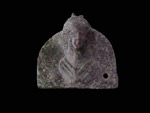
Photo Copyright 2005
David Xavier Kenney |
|
Gallo Roman Bronze Applique Of Diana
From an Antiquities Dealer in England. This is an applique of the Roman goddess Diana. A similar bronze (Less the crowned horns) was found at the site of the hill top fort of Alesia (St. Reine, France). Alesia is most famous for the Battle Of Alesia where Julius Caesar defeats Vercingetorix in 52 BC, but less known is that it had also been an ancient center for bronze works. This may be the image of a Gaulish Diana, possibly the moon/hunting goddess known as Arduinna (Lady Of The Forests). Though with that said it is thought that Arduinna was popular in the region of the Ardennes only, also Arduinna is usually identified due to her sacred animal, the boar.
Private Collection of Renee Z. Bakarian.
Copyright 2005 David Xavier Kenney. All Rights Reserved.
Click here to view larger image. |
|
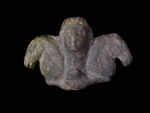
Photo Copyright 2005
David Xavier Kenney |
|
Gallo Roman Bronze Artifact Of The Goddess Epona
From an Antiquities Dealer in England. This is a bronze artifact that shows the Gallic horse goddess Epona. This is the same horse goddess that would become a favorite with the Roman Cavalry and eventually find a place of honor at Rome. For some unknown reason bronze representations of this goddess are quite rare. The style as seen on the miniature bust is very similar to statues and carvings of Epona that are from the area of ancient Alesia (St. Reine, France). The two flanking heads motif can be seen with more ancient Celtic and Scythian sword pommels. The three leafed water lilly on the bottom also shows that this Epona had been connected to inland water, but also suggest that she had originally been a goddess of the dawn. There are a few other depiction's of Epona which also show a water connection. All this could prove to be significant as the goddess Rhiannon (Epona's Celtic Welsh equivalent) is considered by some to be the inspiration for Vivien or Vivienne (The Lady Of The Lake) of Arthurian legend. This artifact shows that the Gallo Roman goddess Epona should also be given that same consideration.
Private Collection of David Xavier Kenney.
Copyright 2005 David Xavier Kenney. All Rights Reserved.
Click here to view larger image. |
|
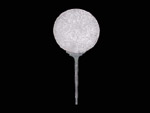
Photo Copyright 2005
David Xavier Kenney |
|
Roman Woman's Silver and Bronze Mirror
From an Antiquities Dealer in California. A Roman women's silver and bronze mirror with a cupid or lares head on the back. The silver portion has been polished.
Private Collection of Linda Rouleau.
Copyright 2005 David Xavier Kenney. All Rights Reserved.
Click here to view larger image. |
|
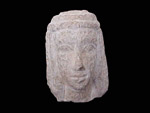
Photo Copyright 2005
David Xavier Kenney |
|
Egyptian Limestone Statue Head of Cleopatra as the Goddess Isis
From Egypt via an Antiquities Dealer in NYC. A limestone statue head of Cleopatra VII as the Egyptian goddess Isis. The headdress appears to have been removed in ancient times, also that same area shows traces of red paint.
Private Collection of David Xavier Kenney.
Copyright 2005 David Xavier Kenney. All Rights Reserved.
Click here to view larger image. |
|

Photo Copyright 2006
David Xavier Kenney |
|
Roman Gladius Sheath Mount Strip Depicting
The Death of Cleopatra
For additional information and images on this artifact, Click Here!
|
|
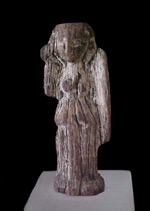
Photo Copyright 2006
David Xavier Kenney |

Photo Copyright 2006
David Xavier Kenney |
|
Egyptian (with Kushite influence) Statue Pendants
For additional information and images on this artifact, Click Here! |
|
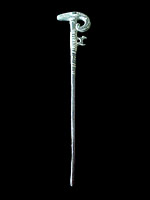
Photo Copyright 2006
David Xavier Kenney |
|
Roman Dacian Hair Pin With An Egyptian Theme
This is a 2nd to 3rd C. AD Bronze Roman Dacian Woman's Hair Pin With An Egyptian Theme. It came from the Balkans and was purchased from a dealer in Germany. It appears that this hair pin was made and balanced to be used as a hand punch weapon. The top has a ram's head in the shape of a hammer. The ram's head suggests the Egyptian national creator god Ra Amon (a solar fertility god) , but the hammer suggests the Egyptian god Ptah, who is a creator god of architects, craftsmen, artists, and metal smiths. The pin itself has rope rings (and/or neck rings) and a cat-like creature. To my knowledge, there is only one other known depiction of such a creature in this climbing or running position; that is the 1st dynasty depiction of the goddess Mafdet (this is mentioned in more detail in the previous artifact description of the statue pendant). The art is somewhat African and suggests that the design may be from southern Egypt, possibly from Meroe (aka Kush and Nubia).
Private Collection of Renee Z. Bakarian.
Copyright 2005 David Xavier Kenney. All Rights Reserved.
Click here to view more images.
Posted On: 20-Jul-06 |
|
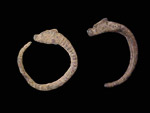
Photo Copyright 2005
David Xavier Kenney |
|
Roman Bronze Loop Earrings
From a Coin Dealer in Israel. Two bronze loop earrings of a wolf head and a dog's head. The wolf's head and band looks to be in imitation of a Dacian wolf windsock standard. The dog's head looks similar to that of a Canis Pugnax (Roman war dog). Although these appear to have originated from the Middle East they could only have been for women associated with Roman legionaries.
Private Collection of Renee Z. Bakarian.
Copyright 2005 David Xavier Kenney. All Rights Reserved.
Click here to view larger image. |
|
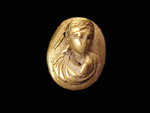
Photo Copyright 2005
David Xavier Kenney |
|
Roman Gold Miniature Sculpture of the Empresses Plotina as Venus
From an Antiquities Dealer in Missouri. This is a Roman Gold Miniature Sculpture of the Empress Plotina as the goddess Venus. This miniature work of art most likely would have been an inset for a ring of a woman of the Patrician class. Pompeia Plotina was the wife of the Emperor Trajan and Rome's most revered Empress.
Private Collection of Linda Rouleau.
Copyright 2005 David Xavier Kenney. All Rights Reserved.
Click here to view larger image. |
|
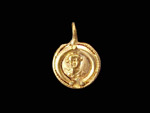
Photo Copyright 2005
David Xavier Kenney |
|
Thraco Dacian Gold Miniture Pendent of the Goddess Bendis
From an Antiquities Dealer in California. A Thraco Dacian gold pendant of the goddess Bendis. This style of Bendis appears to be associated with the lunar aspects of that goddess, but perhaps also with a bear cult.
Private Collection of David Xavier Kenney.
Copyright 2005 David Xavier Kenney. All Rights Reserved.
Click here to view larger image.
To go back to KingArthurBanner.com website click here. |
|

Photo Copyright 2005
David Xavier Kenney |
|
Thraco Dacian Bronze statue of the Goddess Bendis or Cybele?
From an Antiquities Dealer in Germany. A Thraco Dacian bronze statue of the goddess Bendis or Cybele? The statue shows what could be a likeness to a lioness face. This statue has been purposely made for the viewer to look down while the statue (face) looks up.
Private Collection of Renee Z. Bakarian.
Copyright 2005 David Xavier Kenney. All Rights Reserved.
Click here to view larger image. |
|
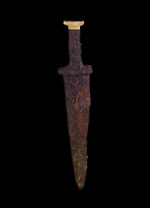
Photo Copyright 2005
David Xavier Kenney |
|
Sarmatian Gold Pommel Iron Short Sword
Sarmatian Gold Pommel Iron Short Sword Circa 300 to 100 B.C. found in the Crimea. The sword's T pommel has a honey colored garnets on each terminal and is covered by hammered gold foil, some of the handle has the impressions of fabric that shows that the handle had once been wrapped with gold wire. The blade has fossilized wood remnants of the sword's sheath. Although it is not probable there is nevertheless a very slight possibility that this sword had once been wielded by a Sarmatian Woman Warrior.
Private Collection of Linda Rouleau.
Image copyrighted 2005. All rights reserved.
Click here to view larger image. |
|
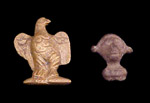
Photo Copyright 2005
David Xavier Kenney |
|
Legionary Prayer Statues
Roman Legionary Eagle Standard and Dacian Goddess Bendis (or a god associated with Bendis) Prayer Statues. Both statues can be attributed to a Dacian serving as a legionary with the Legio XIII Gemina (twin legion). The Bendis prayer statue has the numerals XIII engraved on the front and is also a seal stamp that will produce a seal of a dragon/snake.
Private Collection of David Xavier Kenney.
Image copyrighted 2005. All rights reserved.
Click here to view larger image. |
|

Photo Copyright 2005
David Xavier Kenney |
|
Roman Dacian Bronze statue of the Dacian Amazon goddess Bendis
Roman Dacian Bronze statue of the Dacian Amazon goddess Bendis from the Roman Imperial era, the statue is 38mm x 33mm. This statue has been
purposely made for the viewer to look down while the statue (face) looks up. She wears the knit cap of the males of the Thraco/Dacian aristocracy.
Private Collection of Renee Z. Bakarian.
Image copyrighted 2005. All rights reserved.
Click here to view larger image. |
|
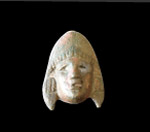
Photo Copyright 2005
David Xavier Kenney |
|
Roman Dacian Bronze statue of the Dacian Amazon goddess Bendis
Roman Dacian Bronze statue of the Dacian Amazon goddess Bendis from the Roman Imperial era, the statue is 62mm x 38mm. This statue has been
purposely made for the viewer to look down while the statue (face) looks up. She wears the knit cap of the males of the Thraco/Dacian aristocracy.
Private Collection of Renee Z. Bakarian.
Image copyrighted 2005. All rights reserved.
Click here to view larger image.
to go back to King Arthur Banner to view the "Torc Bear Meteorite Pendant of The Thraco Dacian Goddess Bendis" Click Here. |
|
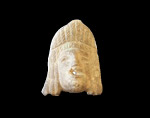
Photo Copyright 2005
David Xavier Kenney |
|
Roman Dacian Bronze statue of the Dacian Amazon goddess Bendis
Roman Dacian Bronze statue of the Dacian Amazon goddess Bendis from the Roman Imperial era, the statue is 69mm x 50mm. This statue has been
purposely made for the viewer to look down while the statue (face) looks up. She wears the knit cap of the males of the Thraco/Dacian aristocracy.
Private Collection of Renee Z. Bakarian.
Image copyrighted 2005. All rights reserved.
Click here to view larger image. |
|
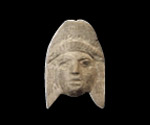
Photo Copyright 2005
David Xavier Kenney |
|
Roman Dacian Bronze statue of the Dacian Amazon goddess Bendis
Roman Dacian Bronze statue of the Dacian Amazon goddess Bendis from the Roman Imperial era, the statue is 44mm x 33mm. This statue has been
purposely made for the viewer to look down while the statue (face) looks up. She wears the knit cap of the males of the Thraco/Dacian aristocracy.
Private Collection of Renee Z. Bakarian.
Image copyrighted 2005. All rights reserved.
Click here to view larger image.
to go back to King Arthur Banner to view the "Torc Bear Meteor Pendant of The Thraco Dacian Goddess Bendis" Click Here. |
|
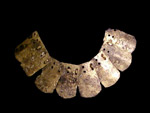
Photo Copyright 2005
David Xavier Kenney |
|
Roman Officer's Armor Piece
Roman Officer Gold Gilded Scale Armor Piece from the Roman Imperial Era. This scale armor piece was found with Roman cavalry artifacts along Hadrian's Wall in Britain. The style of the scale armor piece is Roman but the gold gilding could suggest that it is of a high ranking Roman Officer influenced by an Asiatic or Euro Asiatic people. Asiatic Scythian auxiliaries and Euro Asiatic Sarmatian auxiliaries are thought to have been in the area of Hadrian's Wall. Speculations are that some Sarmatian women may have been warriors. This is primarily due to Herodotus's (an ancient Greek historian and researcher) account of them, and a few weapons finds in graves of female Sarmatians.
Private Collection of David Xavier Kenney.
Image copyrighted 2005. Revised Feb 2007 All rights reserved.
Click here to view larger image. |
|

Photo Copyright 2005
David Xavier Kenney |
|
Roman Dacian Alani Bronze Bear Head and Obsidian Arrow/Spearhead Locket
Roman Dacian Alani Bronze Bear Head and Obsidian Arrow/Spearhead Pendant Locket (Possibly an earring locket) from the Roman Imperial Era. This locket is made in the shape of a bear's face. The two rivets on the bear's ears secure the locket. Besides resembling a bear's face, the locket is similar to the shape of Roman female stimulators. These metal stimulators were once worn on thongs by ancient Roman women and have been discovered with artifacts which are typically found near the sites of ancient Roman brothels. This obsidian arrow/spearhead is made from obsidian with black on the outer edges and clear mahogany/red obsidian in the center. The arrow/spearhead is made so that if the locket is reversed, the obsidian's form appears to be in the shape of a heart. Concerning the position of the arrow/spearhead, there are similar Frankish Dacian Alani legionary auxiliary gold gilded bear head appliques that have a distinct flame in the center of the bear's forehead. The obsidian has the Greek Letters IO and TX engraved on it. The IO is Greek for the word THE and the TX is the Greek abbreviation for Tex which is the root word for TECHNE, which means "of the Fine Arts." There is little doubt that this locket's motif is associated with the constellation Arcturus, or the constellation Ursa Major, or the constellation Ursa Minor. The miniature symbolic utility design of this locket should be associated with female independence and the erotic in ancient times.
Private Collection of David Xavier Kenney.
Image copyrighted 2005. All rights reserved.
Click here to view larger image. |
| |
|
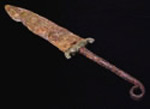
Photo Copyright 2005
David Xavier Kenney |
|
Roman Dagger Attributed to a Gladiatrix (Female Gladiator) Pugio
For additional information and images on this artifact, Click Here!
|
|
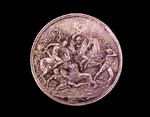
Photo Copyright 2005
David Xavier Kenney |
|
Roman Silver Mercury Alloy Palm Mirror
For additional information and images on this artifact, Click Here!
|
|
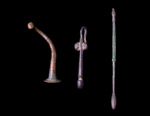
Photo Copyright 2005
David Xavier Kenney |
|
Bronze Cosmetic Utensils
Roman Women's Bronze Cosmetic Utensils, from left to right:
- Eye Shadow Applicator
- Phallic Lipstick Applicator
- Dual Purpose Lipstick and Eye Liner Applicator
Private Collection of Linda Rouleau.
Image copyrighted 2005. All rights reserved.
Click here to view larger image.
|
|
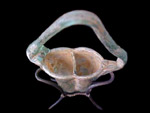
Photo Copyright 2005
David Xavier Kenney |
|
Roman Glass Double Cosmetic Tube
This is a Roman glass double cosmetic tube from the Eastern Mediterranean. This type of glass container had once been used to hold kohl (black eye paint) and various other cosmetics.
Private Collection of Renee Z. Bakarian.
Image copyrighted 2005. All rights reserved.
Click here to view larger image.
|
|
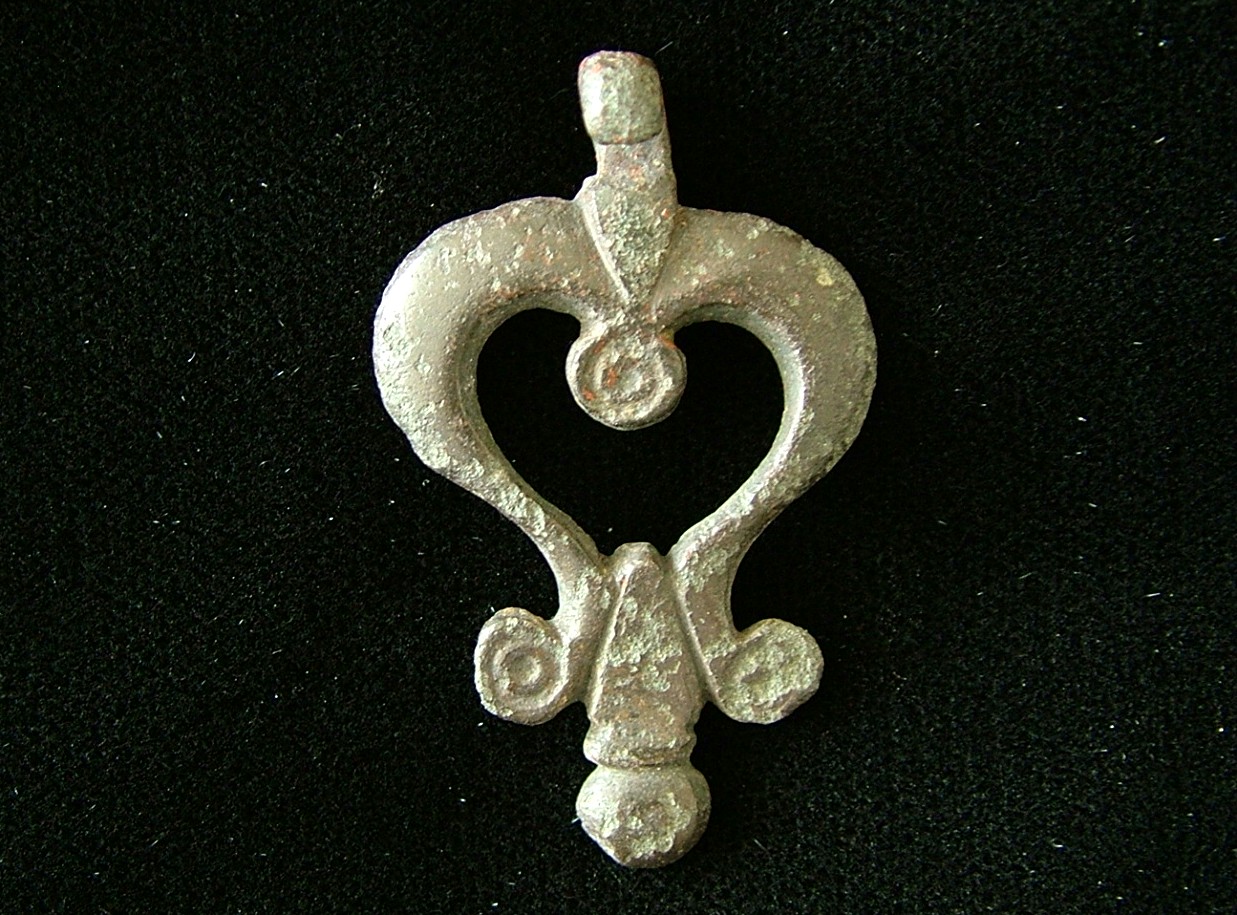
Photo Copyright 2008
David Xavier Kenney |
|
Roman Meretrix (Prostitute) Head Band Pendant
The pendant would have been worn on the front of a head band. It's specific iconography shows that the Meretrix had an identity with the Centurions of the Classis Syriaca. |
|
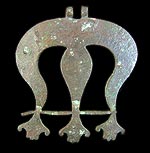
Photo Copyright 2007
David Xavier Kenney |
|
Roman Meretrix Pendant
This is a 1st to 3rd C. AD Copper Meretrix (Roman Prostitute) Pendant (. It is 6.7 cm x 5.9 cm. It is made to represent; a woman's head, the letter M, and three wavy arms (and hands) that are bound by a line (perhaps suggesting talents as a masseuse, or implying that the Meretrix was a slave). The cutout shows two facing birds, a Roman symbol for love. Turned upside down it may represent; a harp, flames, and three flowers. The Romans associated the metal copper with Venus, hence a metal that was favored by prostitutes. There is little doubt that this pendant is a suggestive advertisement.
Private Collection of Renee Z. Bakarian.
Image copyrighted 2007. All rights reserved.
Click here to view larger image.
|
|

Photo Copyright 2008
David Xavier Kenney |
|
Meretrix Amazon Whip
Information to follow soon. |
|
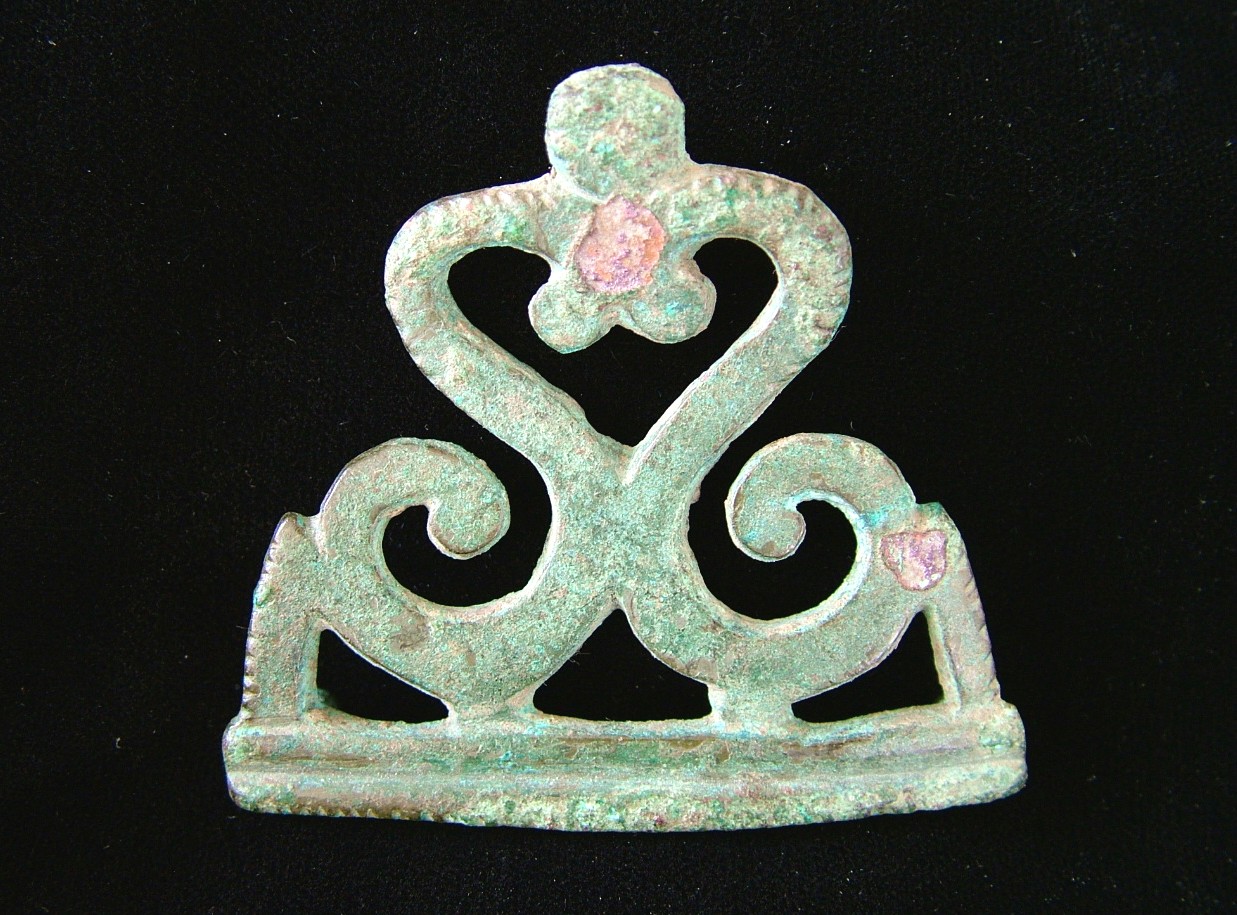
Photo Copyright 2008
David Xavier Kenney |
|
Roman Meretrix (Prostitute) Box Applique Of A Centurio Classicus (Marine Centurion) Of Classis Syriaca (Roman Syrian Fleet)
Information to follow soon. |
|
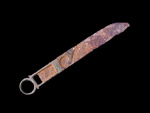
Photo Copyright 2005
David Xavier Kenney |
|
Roman or Byzantine Lady's Shaver
This is a bronze and iron Roman or Byzantine lady's shaver. It appears originally that there may have also have been ivory, bone, or mother of pearl on the handle. This small shaver is made to be held by the index finger and the thumb, that is comfortably for someone with small hands (no larger than a size 6 ring finger). According to ancient statue nudes, Roman women were always shown without body hair. The techniques that were used to accomplish this were by waxing, shaving, or both.
Private Collection of Renee Z. Bakarian.
Image copyrighted 2005. All rights reserved.
Click here to view larger image.
|
|
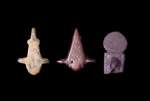
Photo Copyright 2005
David Xavier Kenney |
|
Roman Female Stimulators
These are three Roman bronze Meretrix (Roman Prostitute) stimulators. The first stimulator is purported to have originated from Lebanon. The second and third stimulators are purported to have originated from the Balkans, these were with legionary artifact finds. The first stimulator is made in the shape of a fish and has three gold nails (representing three gold balls, from great antiquity it is a bear head symbol, after the Roman Period it can take on other meanings) for a finger grip. The inside top shows among other things a painted griffin. The second stimulator is shaped as an arrowhead, there is a flower and leaves engraved on this, the flower is shaped like an arrowhead or spearhead. The third stimulator is shaped like a mirror on a box with a phallus. It was worn with the mirror on top, the box outward, and the phallus inverted. The various loops and, or holes on these stimulators show that they were worn on thongs, when not in use they could comfortably have been worn as pendants, possibly on the same thongs.
Private Collection of Linda Rouleau.
Copyright 2008 David Xavier Kenney
Image copyrighted 2005. All rights reserved.
Click here to view larger image.
|
|
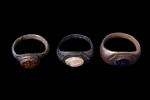
Photo Copyright 2005
David Xavier Kenney |
|
Roman Women's Rings
These are three size 6 Roman ladies' intaglio rings, from left to right:
-
Silver carnelian intaglio ring showing two winged cupids holding hands.
-
Bronze quartz crystal intaglio showing a bearded man in portrait that is reversible.
-
Bronze onyx intaglio showing a turtle (Sacred to Venus).
Private Collection of Renee Z. Bakarian.
Image copyrighted 2005. All rights reserved.
Click here to view larger image.
|
|
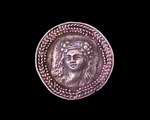
Photo Copyright 2005
David Xavier Kenney |
|
Roman Goddess Flora Silver Roundel
This is a silver roundel depicting the goddess Flora. Flora is a fertility goddess of flowers and spring, and presides over her festival, the Floralia, from April 28th to May 3rd. Another of her festivals is the festival of roses. Flora is a goddess of youthful pleasure and she could be quite licentious. Flora was married to Zephyr, the god of the south wind, but was also a co-mother (with Juno) of Mars, the god of war. For obvious reasons, this goddess was a favorite of Roman soldiers.
Private Collection of Linda Rouleau.
Image copyrighted 2005. All rights reserved.
Click here to view larger image.
|
|
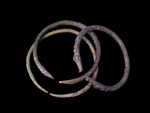
Photo Copyright 2005
David Xavier Kenney |
|
Roman Dacian Bracelets
These are three Roman Dacian bracelets, each with a pair of different greyhound (Roman racing dogs) heads.
Private Collection of Renee Z. Bakarian.
Image copyrighted 2005. All rights reserved.
Click here to view larger image.
|
|
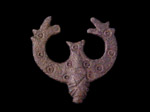
Photo Copyright 2005
David Xavier Kenney |
|
Ostrogothic Applique?
This is thought to be an Ostrogothic (With Alanic influence) bronze applique of a River Naga (River Spirit). Shown upside down, it is a dragon ship. Most likely it originates from the Ostrogoths when they were in the east, or it is from another culture near the Meotian Sea (Sea of Azov). The applique has traces of gold gilt.
Private Collection of David Xavier Kenney.
Image copyrighted 2005. All rights reserved.
Click here to view larger images.
|
|
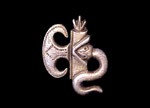
Photo Copyright 2005
David Xavier Kenney |
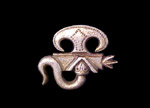
Photo Copyright 2005
David Xavier Kenney |
|
Thraco Sarmatian Axe and Ship Brooch Commemorating The Battle Of Actium
This artifact is a Thraco Sarmatian axe and ship brooch from the 1st century BC. The first view of this brooch shows a snake, a punch dot horizontal spearhead or arrowhead, and an axe head with a punch dot line around the axe's edge. The position of the axe head and the spearhead/arrowhead could also suggest a bow and arrow. The second view shows the snake and spearhead/arrowhead, the letter A, a ship's sail, and a ship with a three-pronged ram (this type of ram is thought not to have been used after 14 AD). This brooch's art, with the snake and the punch dot symbols, appears to symbolize the use of viper venom on an axe head (viper venom may have been the snake poison of choice).
This brooch appears to have been made for a veteran of the battle of Actium in 31 BC. Specifically it appears to have been made for a Sarmatian Marine who originated from the Crimean city of Olbia. Coins from Thracian Olbia show an axe and bow that is Sarmatian and very similar to the art on this artifact. Prior to the Thracian conquest Olbia had been a Greek colony with a great influx of Sarmatians. Elements of a Thracian fleet had fought at Actium for both Octavian and Anthony. That same year the Romans conquered Thrace (including the city of Olbia) and made it a protectorate. There is always the possibilty that this brooch also could be symbolic of Achilles, his ship, and a poisoned battle axe.
Private Collection of David Xavier Kenney.
Image copyrighted 2005. All rights reserved.
Click here to view larger image.
|
|
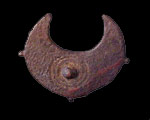
Photo Copyright 2005
David Xavier Kenney |
|
Thraco (Dacian) Sarmatian Shield Brooch
This is a Thraco (Dacian) Sarmatian shield brooch. The brooch had been silvered and the boss has traces of gold gilt. The first view shows the shield as it was carried. The second view shows how the shield was held at the ready. This may explain a Thraco Sarmatian battle tactic: The shield while carried was meant to be viewed as a quarter moon. As the shield was made ready it was viewed by any onlooker as a woman's breast. With this symbolism, several hundred or more warriors going from the carry shield to the ready position would have given a tremendous pre-battle image impact to any enemy.
Private Collection of Renee Z. Bakarian.
Image copyrighted 2005. All rights reserved.
Click here to view larger image.
|
|

Photo Copyright 2005
David Xavier Kenney |
|
Roman Thraco (Dacian) Sarmatian Fibula
This is a Roman Thraco (Dacian) Sarmatian bronze fibula. The first view shows a ship hull and mast, which suggests Roman riverine auxiliaries. The second view, with the fibula turned upside down, depicts the Dacian wolf wearing a massive headdress typical of the ceremonial horse's headdress seen in the art of the Scythians and Sarmatians.
Private Collection of David Xavier Kenney.
Image copyrighted 2005. All rights reserved.
Click here to view larger image.
|
|
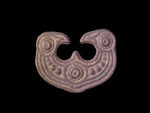
Photo Copyright 2005
David Xavier Kenney |
|
Miniature Roman Sarmatian Standard
This is a miniature Roman Sarmatian double eagle head standard which would have topped a miniature pole which would have been mounted on a base. It is thought that miniature standards were given by Roman Officers as legionary awards (or presentations) to legionaries or auxiliaries.
Private Collection of David Xavier Kenney.
Image copyrighted 2005. All rights reserved.
Click here to view larger image. |
|
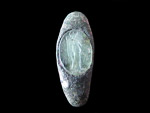
Photo Copyright 2005
David Xavier Kenney |
|
Greco Roman Ring With Intaglio Of Aphrodite Hoplimene
This is a Greco Roman bronze ring with a green glass intaglio of Aphrodite Hoplimene (Soldier) of the acropolis of Korinthos. The intaglio shows Aphrodite holding a rose bud shield that has a spear coming out of it, the spearhead may be a quarter moon. The image also shows a bull's head under her right hand . The nearby Spartans had a similar martial love goddess, the Aphrodite Areia (of Aries). This goddess may very well give an idea as to what the real Helene of Troy was like.
Private Collection of Renee Z. Bakarian.
Image copyrighted 2005. All rights reserved.
Click here to view larger image. |
|
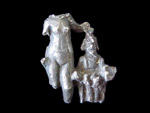
Photo Copyright 2005
David Xavier Kenney |
|
Roman Miniature Statue Fragment Of Venus With Selinos
This is a Roman silver miniature fertility statue fragment of the goddess Venus with the god Silenos as her consort. Most likely this had once been used for votive purposes.
Private Collection of Linda Rouleau.
Image copyrighted 2005. All rights reserved.
Click here to view larger image. |
|
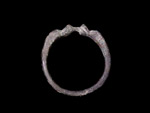
Photo Copyright 2005
David Xavier Kenney |
| Roman Sarmatian Dragon Ring
This is an extremely rare Roman Sarmatian bronze dragon ring. There is little doubt that at an American ring size 11 that this ring had once belonged to a cavalryman. The ring looks to have been worn on the same finger as a military unit ring. Between the mouths of the two dragon heads a bridge is shown. This bridge motif could lead to much speculation but may be associated with a Sarmatian view of Trajan's bridge. Sarmatians fought on both sides during Trajan's Dacian Wars.
Private Collection of David Xavier Kenney.
Image copyrighted 2005. All rights reserved.
Click here to view larger image.
Private Collection of David Xavier Kenney
|
|
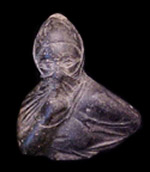
Photo Copyright 2005
David Xavier Kenney |
| Palmyran Statue Fragment of a Veiled Dancer
This is an extremely rare 1st C. AD black burnished terracotta statue fragment of a Palmyran Veiled Dancer. It is one of only two known images of an ancient veiled dancer that is in fact wearing a veil. Many thanks Nadia!
Private Collection of David Xavier Kenney
Image copyrighted 2005. All rights reserved.
Click here to view larger image.
|

